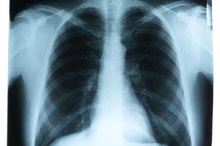Abnormal Breathing Sounds
Breathe in, breathe out. Other than the soft whoosh of air, no other sounds should be heard when your doctor listens to your lungs. **Anything other than these regular breath sound is considered abnormal 1.
If you are experiencing serious medical symptoms, seek emergency treatment immediately.
** When altered breath sounds are heard, they usually indicate a medical condition affecting the lungs or airways 1.
From obstructions to infections, different sounds give your doctor an idea of what is happening in your airways. A stethoscope is necessary to hear many of these sounds. More than one abnormal breath sound can be present, depending on what is causing the altered airflow.
Rales
Rales, or crackles, refer to intermittent bubbling or popping sounds much like static on the radio. They are more commonly heard with inspiration, but can occur with exhalation. Crackles are usually caused by fluid or other secretions in the small airways of the lungs. They commonly occur with conditions such as pneumonia, chronic bronchitis and heart failure. Rales are further broken down into moist, dry, fine and coarse 2.
Fine crackles are soft sounds similar to the sound produced when rolling several strands of hair together near the ear. Coarse crackles are similar to the sound of Velcro being pulled apart.
- Rales, or crackles, refer to intermittent bubbling or popping sounds much like static on the radio.
- Fine crackles are soft sounds similar to the sound produced when rolling several strands of hair together near the ear.
Rhonchi
What Muscles Are Used When Coughing?
Learn More
Rhonchi are low-pitched sounds heard continuously during inhalation or exhalation. These relatively loud breath sounds are similar to a rumbling snore or gurgling [1](# 'inline-reference::Auscultation Skills: Breath and Heart Sounds; Jessica Shank Coviello, D.N.P.
')3. Often referred to as a low-pitched wheeze, rhonchi can sometimes be heard without a stethoscope. They indicate increased secretions in the larger airways of the lungs, and are often present with conditions such as pneumonia, chronic bronchitis and cystic fibrosis. Rhonchi often disappear temporarily after coughing, which clears phlegm from the large airways.
- Rhonchi are low-pitched sounds heard continuously during inhalation or exhalation.
- Rhonchi often disappear temporarily after coughing, which clears phlegm from the large airways.
Wheezing
Wheezing is a musical, whistle-like or squeaky sound that can often be heard without a stethoscope. It is usually high-pitched and is most often heard during exhalation, though it sometimes occurs with inhalation. Wheezing indicates airway narrowing or partial blockage. The sound is produced as air is forced through an abnormally narrow airway.
Wheezing is a hallmark sign of asthma, which causes airway spasms and narrowing. Wheezing also frequently occurs with chronic obstructive pulmonary disease, as the condition characteristically causes airway narrowing.
- Wheezing is a musical, whistle-like or squeaky sound that can often be heard without a stethoscope.
- Wheezing is a hallmark sign of asthma, which causes airway spasms and narrowing.
Stridor
Allergies and Lung Crackle While Exercising
Learn More
Stridor is a harsh, high-pitched sound that is easily heard without a stethoscope and indicates airflow blockage at the level of the windpipe or voice box. It is most frequently heard with inhalation, but may also be present during exhalation. Stridor often occurs in children with croup.
Other upper airway infections, accidentally inhaling a foreign object and a severe allergic reaction can also cause stridor. A tumor of the upper airway is another possible cause.
Sudden or severe stridor often indicates a serious upper airway obstruction requiring emergency medical attention. Upper airway blockage can lead to severe respiratory distress if air cannot move into or out of the lungs efficiently.
- Stridor is a harsh, high-pitched sound that is easily heard without a stethoscope and indicates airflow blockage at the level of the windpipe or voice box.
- Sudden or severe stridor often indicates a serious upper airway obstruction requiring emergency medical attention.
Pleural Friction Rub
Each lung rests inside a two-layered pleural sac that enables it to inflate and deflate within the chest with minimal friction. Inflammation of this sac, known as pleurisy or pleuiritis, can occur with a variety of conditions.
As the inflamed pleural layers rub against one another or nearby structures during breathing, a low-pitched creaking, grating or rubbing sound may be heard.
This sound, known as a pleural friction rub, is more common with inhalation but sometimes occurs during exhalation. It can only be heard with a stethoscope. Possible causes include viral or bacterial pneumonia, a lung abscess, rheumatoid arthritis and lung cancer.
- Each lung rests inside a two-layered pleural sac that enables it to inflate and deflate within the chest with minimal friction.
- As the inflamed pleural layers rub against one another or nearby structures during breathing, a low-pitched creaking, grating or rubbing sound may be heard.
Cautionary Notes
If you or a member or your family experience difficulty breathing, seek immediate medical attention. Sudden wheezing or stridor, especially, may indicate a potentially life-threatening condition. See your doctor if you have an unexplained cough lasting longer than 7 to 10 days, especially if accompanied by other symptoms such as fever, chest pain, weight loss, dizziness or weakness.
Reviewed by: Tina M. St. John, M.D.
- If you or a member or your family experience difficulty breathing, seek immediate medical attention.
- See your doctor if you have an unexplained cough lasting longer than 7 to 10 days, especially if accompanied by other symptoms such as fever, chest pain, weight loss, dizziness or weakness.
Related Articles
References
- Auscultation Skills: Breath and Heart Sounds; Jessica Shank Coviello, D.N.P.
- Emergency Care and Transportation of the Sick and Injured, 9th Edition; Andrew N. Pollack, M.D.
- Practical Clinical Skills: Breath Sounds Reference Guide
- Clinical Manifestations and Assessment of Respiratory Disease, 6th Edition; Terry DesJardins and George G. Burton
- Broaddus, V. Courtney. Murray and Nadels Textbook of Respiratory Medicine. Saunders, 2015.
- Sarkar M, Madabhavi I, Niranjan N, Dogra M. Auscultation of the Respiratory System. Annals of Thoracic Medicine. 2015. 10(3):158-168. doi:10.4103/1817-1737.160831
Writer Bio
Dr. Franchesca Vermillion is based in Portland, Ore. and has been writing health-related material for her patients and for public speaking events for more than four years. Vermillion obtained her Bachelor of Arts in molecular biology from the University of Denver in 2001 and her Chiropractic Physician's Degree from University of Western States in 2006.






